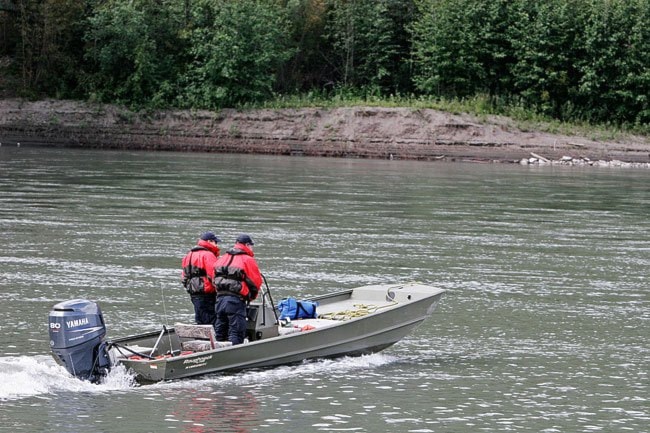The inquest into the death of Const. Michael Potvin isn’t looking to blame anyone for the accident, but that didn’t stop Potvin’s father Mark - who is representing the family at the inquest - from asking some tough questions of his son’s commanding officer.
Cpl. Brent Chapman was piloting the boat when it capsized on the Stewart River in July of 2010.
It was the first time he had taken the boat out on the river.
Cpl. Chapman had only taken command of the Mayo detachment a month before the accident.
When he arrived, the boat was in rough shape.
None of the electrical systems worked, including the bilge pump. But it had even more serious issues.
The day before the accident, Insp. Andreas Seidemann, who was visiting the detachment, told Chapman that the boat had nearly killed two people the year before.
In October of 2009, Const. Andreas Seidemann - the inspector’s son - and Const. Mitch Hutton had taken the boat out on a hunting trip on Mayo Lake.
At the time they were both off duty.
They had only been out on the lake for an hour when the weather changed and the water got choppy.
They decided to go back, but the motor stalled. With the boat stopped, waves began to crash over the back. The boat started to take on water.
While Seidemann tried to get the motor started, Hutton started to bail out the boat with a battery box.
Some kind of black oil had leaked out from somewhere and covered the deck, which made it hard to bail, testified Hutton.
“I couldn’t stand without holding on to boat,” he said.
With the primer pump stuck flat, Sidelmann had to take off the fuel filter to pop it back out to get fuel to the motor.
They were able to get it running. But when he put the throttle up, the engine stalled. Eventually they were able to return to shore under low power.
It was an unnerving experience, Hutton told the inquest.
“I felt it was the end of my life,” he said.
At one point the two officers shook hands and said their goodbyes.
The commanding officer of the detachment, Sgt. Dave Wallace, returned from vacation the next day and was told about the incident.
It wasn’t relayed to him as particularly serious so no hazardous incident report was filed, he testified.
He assumed that water must have gotten into the motor so he put some gas-line antifreeze into the system, hoping to solve the problem.
No vessel or maintenance log was completed, and the post-season report, which Wallace had filled out before going on leave, was never amended.
In fact no paperwork of any kind was filed.
However, both Chapman and Potvin were aware of the problems with the boat.
When they took out the boat the day of the accident, the idea was to test the vessel and the motor, said Chapman.
They did two trips.
The first time both officers were wearing a personal flotation device.
On that trip, the motor stalled after they got about one kilometre up river. Chapman assumed they were just out of gas.
They returned to the boat launch using the auxiliary motor and refuelled.
Chapman went to get the gas while Potvin stayed with the boat.
While on shore, they both took off their PFDs.
Chapman testified that he draped his over the seat, but after coming back with the fuel he didn’t remember seeing it.
The second time out, neither officer was wearing one.
As the commanding officer, and the one with water transport training, it was Chapman’s responsibility to make sure proper safety equipment was worn.
When the boat capsized he thought they were wearing their PFDs. Chapman told the inquest that it wasn’t until he was pulled out of the water by the rescue boat that he realized he wasn’t wearing one.
On that second trip the motor stalled out as well. They were able to get it going again, but every time he put the throttle up it stalled again.
Every time they stopped the wake would splash over the back. By the fourth time the stern was completely submerged, said Chapman.
He gave up on the main motor and moved to the back to use the auxiliary motor. Potvin stayed at the bow and directed Chapman because he couldn’t see where they were going with the boat tipped up.
Chapman testified that he assumed that the boat would remain stable even while swamped with water. It’s an assumption that Mark Potvin found hard to accept.
Chapman said they were about 15 metres from the boat launch when it capsized.
He said he saw Potvin jump from the bow.
“I don’t remember him hanging on to boat,” said Chapman. But with the boat in between them, he couldn’t see Potvin at all at first.
By the time he came around, Potvin was already swimming for shore.
Chapman said he didn’t call Potvin back because by that time he was already halfway to the river bank.
While people on shore testified that they heard the officers talking loudly, Chapman said he couldn’t recall the conversation.
The last time he saw Potvin was in the water.
“His upper torso was out of the water and he was yelling my name, so I assumed he had already reached shore,” said Chapman. It wasn’t until the rescue boat pulled Chapman to safety that he learned Potvin was missing.
Chapman continued to search that night but was taken off duty the next day.
When he came back two weeks later he continued the search.
He was on the boat that found Potvin’s body 17 days after the accident, about 60 kilometres downstream.
The inquest continues today and is scheduled to wrap up next week.
Contact Josh Kerr at
joshk@yukon-news.com
